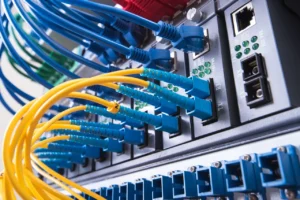Ever tried looking through a dirty window?
It messes up the view, dulls the light and makes it difficult to see anything with any clarity. You probably already knew that fibre optic cable uses beams of light… But, did you know it’s also affected by dirt?
It makes sense though, doesn’t it? Every connection in any fibre optic infrastructure can be thought of as a window, like the interconnects on fibre patch panels, patch leads and SFPs.
These connections are designed to allow the light from the terminating devices to pass through, without obstruction and in a secure manner.
Fibre optic networks use infra-red light, so you can’t see it. Do not look into a connector or patch cable without making sure it is NOT in use! The likelihood is you won’t see the dust or dirt anyway. You need a specialist magnification tool.
How do they get dirty?

Comms rooms, server rooms and data-centres have a lot of air moving around in them, particularly through the racks. Servers, switches, routers and other equipment all have fans which draw air from one side to the other to aid their cooling.
This movement of air typically brings airborne dust particles with it, which is why you often see dusty fans at the back of computers. This dust will settle on any surface and over time will eventually turn quite grimy.
Copper connections don’t suffer anywhere near as badly as fibre connections. If the RJ45 contacts do get a layer of dirt on them it’s usually removed by the friction of inserting the plug and making the connection. Plus, there’s a much greater contact area.
Fibre optic doesn’t behave the same way. When you plug fibre optic cables in, you are essentially just marrying together two windows so that the light can pass through.
If there’s a layer of dust on either face it will inhibit the signal being passed.
What do I need to do?

First of all, keep the dust caps on!
It helps stop the ingress of dust, dirt and grime into the connector and onto the face. The same goes for the fibre patch leads, they will also have dust caps that should be kept on until they are used.
You could also try to reduce the amount of dust introduced into the atmosphere. Avoid using the room for storage. Cardboard boxes, Christmas decorations, old marketing brochures, even mannequins… we’ve seen it all! These things all add to the amount of potential dust.
Invest in some dust control measures. If it’s a purpose built server room or data centre then an industrial dust control system will help remove dust particles from the environment. If it’s a comms room or patch cupboard then think about putting filters over any ventilation and sealing any gaps.
If you think you may be affected by dusty contacts then consider giving them a clean. Typically you can do this with a swab and some isopropyl alcohol, or cleaning wipes. In some cases, if the contamination is bad or issues still persist, it may be necessary to re-terminate and test the fibre connections to see if the issue is something more significant. Trapped cables, crushed cables and chewed cables (rodents) can all cause significant problems with fibre optic networks.
As always, if you need any further advice, or to call on our services, Litenet is here to help. Our engineers have fibre test equipment, splicing equipment, cleaning equipment and bundles of knowledge and experience to help you overcome any fibre issues. We can replace faulty cabling and, in some cases, repair it too. Lost all your dust caps. Drop us a line and we’ll sort you out with some more. Want to consider some dust control measures? We can do that.
Call us on 01908 794 794 or email info@litenetuk.com



